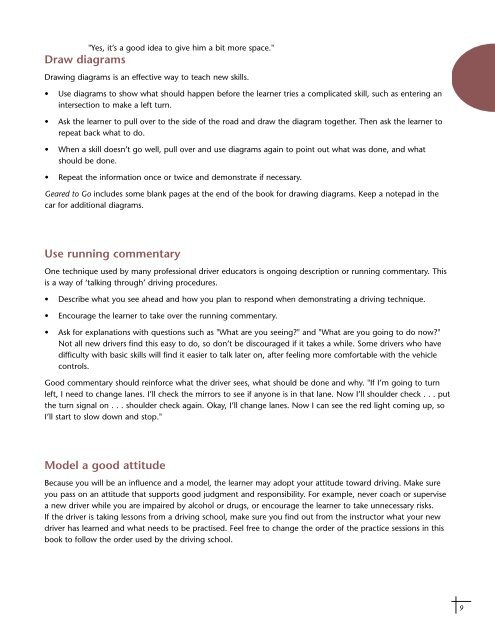Geared to Go A Workbook for Coaching New Drivers
Geared to Go A Workbook for Coaching New Drivers
Geared to Go A Workbook for Coaching New Drivers
Create successful ePaper yourself
Turn your PDF publications into a flip-book with our unique Google optimized e-Paper software.
"Yes, it’s a good idea <strong>to</strong> give him a bit more space."Draw diagramsDrawing diagrams is an effective way <strong>to</strong> teach new skills.• Use diagrams <strong>to</strong> show what should happen be<strong>for</strong>e the learner tries a complicated skill, such as entering anintersection <strong>to</strong> make a left turn.• Ask the learner <strong>to</strong> pull over <strong>to</strong> the side of the road and draw the diagram <strong>to</strong>gether. Then ask the learner <strong>to</strong>repeat back what <strong>to</strong> do.• When a skill doesn’t go well, pull over and use diagrams again <strong>to</strong> point out what was done, and whatshould be done.• Repeat the in<strong>for</strong>mation once or twice and demonstrate if necessary.<strong>Geared</strong> <strong>to</strong> <strong>Go</strong> includes some blank pages at the end of the book <strong>for</strong> drawing diagrams. Keep a notepad in thecar <strong>for</strong> additional diagrams.Use running commentaryOne technique used by many professional driver educa<strong>to</strong>rs is ongoing description or running commentary. Thisis a way of ‘talking through’ driving procedures.• Describe what you see ahead and how you plan <strong>to</strong> respond when demonstrating a driving technique.• Encourage the learner <strong>to</strong> take over the running commentary.• Ask <strong>for</strong> explanations with questions such as "What are you seeing?" and "What are you going <strong>to</strong> do now?"Not all new drivers find this easy <strong>to</strong> do, so don’t be discouraged if it takes a while. Some drivers who havedifficulty with basic skills will find it easier <strong>to</strong> talk later on, after feeling more com<strong>for</strong>table with the vehiclecontrols.<strong>Go</strong>od commentary should rein<strong>for</strong>ce what the driver sees, what should be done and why. "If I’m going <strong>to</strong> turnleft, I need <strong>to</strong> change lanes. I’ll check the mirrors <strong>to</strong> see if anyone is in that lane. Now I’ll shoulder check . . . putthe turn signal on . . . shoulder check again. Okay, I’ll change lanes. Now I can see the red light coming up, soI’ll start <strong>to</strong> slow down and s<strong>to</strong>p."Model a good attitudeBecause you will be an influence and a model, the learner may adopt your attitude <strong>to</strong>ward driving. Make sureyou pass on an attitude that supports good judgment and responsibility. For example, never coach or supervisea new driver while you are impaired by alcohol or drugs, or encourage the learner <strong>to</strong> take unnecessary risks.If the driver is taking lessons from a driving school, make sure you find out from the instruc<strong>to</strong>r what your newdriver has learned and what needs <strong>to</strong> be practised. Feel free <strong>to</strong> change the order of the practice sessions in thisbook <strong>to</strong> follow the order used by the driving school.9




